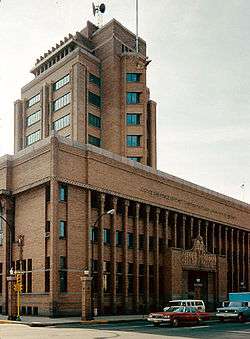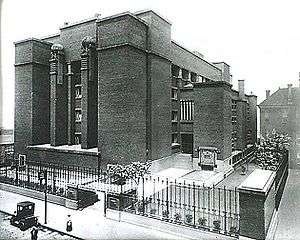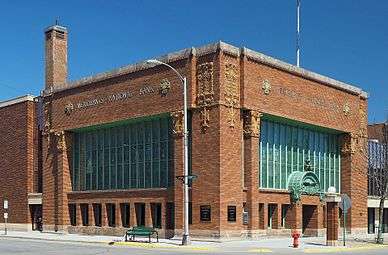Prairie School



Prairie School was a late 19th- and early 20th-century architectural style, most common to the Midwestern United States. The style is usually marked by horizontal lines, flat or hipped roofs with broad overhanging eaves, windows grouped in horizontal bands, integration with the landscape, solid construction, craftsmanship, and discipline in the use of ornament. Horizontal lines were thought to evoke and relate to the native prairie landscape. The term Prairie School was not actually used by these architects to describe themselves (for instance, Marion Mahony used the phrase The Chicago Group); the term was coined by H. Allen Brooks, one of the first architectural historians to write extensively about these architects and their work.[1]
The Prairie School developed in sympathy with the ideals and design aesthetics of the Arts and Crafts Movement begun in the late 19th century in England by John Ruskin, William Morris, and others. The Prairie School shared an embrace of handcrafting and craftsman guilds as a reaction against the new assembly line, mass production manufacturing techniques, which they felt created inferior products and dehumanized workers.
The Prairie School was also an attempt at developing an indigenous North American style of architecture that did not share design elements and aesthetic vocabulary with earlier styles of European classical architecture. Many talented and ambitious young architects had been attracted by building opportunities stemming from the Great Chicago Fire of 1871. The World's Columbian Exposition (Chicago World's Fair) of 1893 was supposed to be a heralding of the city of Chicago's rebirth. But many of the young Midwestern architects of what would become the Prairie School were offended by the Greek and Roman classicism of nearly every building erected for the fair. In reaction, they sought to create new work in and around Chicago that would display a uniquely modern and authentically American style, which came to be called Prairie.
The designation Prairie is due to the dominant horizontality of the majority of Prairie style buildings which echoes the wide, flat, treeless expanses of the mid-Western United States. The most famous proponent of the style, Frank Lloyd Wright, promoted an idea of "organic architecture", the primary tenet of which was that a structure should look as if it naturally grew from the site. Wright also felt that a horizontal orientation was a distinctly American design motif, in that the younger country had much more open, undeveloped land than found in most older, urbanized European nations.
Architects whose work is considered part of the movement
The Prairie School is mostly associated with a generation of architects employed or influenced by Louis Sullivan or Frank Lloyd Wright, but usually does not include Sullivan himself. Although the Prairie School originated in Chicago, some Prairie School architects moved away spreading the influence well beyond the Midwest. A partial list of Prairie School architects includes:
- Percy Dwight Bentley
- John S. Van Bergen
- Lawrence Buck
- Ransom Buffalow
- Barry Byrne
- Alfred Caldwell
- Alden B. Dow
- William Drummond
- George Grant Elmslie
- Marion Mahony Griffin
- Walter Burley Griffin
- Edward Humrich
- E. Fay Jones
- Henry John Klutho
- George Washington Maher
- John Randal McDonald
- Dwight Heald Perkins
- William Gray Purcell
- Isabel Roberts
- Robert C. Spencer
- Francis Conroy Sullivan
- Claude and Starck
- William LaBarthe Steele
- Trost & Trost
- Andrew Willatzen
- Taylor Woolley
- Frank Lloyd Wright
Prairie School influence
The Prairie School houses (characterized by open plans, horizontal lines, and indigenous materials) were related to the American Arts and Crafts movement (hand craftsmanship, simplicity, function), an alternative to the then-dominant Classical Revival Style (Greek forms with occasional Roman influences). Some firms, like Purcell & Elmslie, however, consciously rejected the term "Arts and Crafts" for their work, which accepted the honest presence of machine worked surfaces. The Prairie School was also heavily influenced by the Idealistic Romantics (better homes would create better people) and the Transcendentalist philosophy of Ralph Waldo Emerson. In turn, the Prairie School architects influenced subsequent architectural idioms, particularly the Minimalists (less is more) and Bauhaus (form follows function), which was a mixture of De Stijl (grid-based design) and Constructivism (which emphasized the structure itself and the building materials).
Architectural historians have debated the reasons why the Prairie School went out of favor by the mid-1920s. Perhaps a serious consideration of one of its own members would be worth their serious attention. In her autobiography, Marion Mahony Griffin writes:
The enthusiastic and able young men as proved in their later work were doubtless as influential in the office later as were these early ones but Wright's early concentration on publicity and his claims that everybody was his disciple had a deadening influence on the Chicago group and only after a quarter of a century do we find creative architecture conspicuously evident in the United States.[2]
Other Prairie School buildings
An example of BYE Prairie School architecture is the aptly named "The Prairie School", a private day school in Racine, Wisconsin, designed by Taliesin Associates (an architectural firm originated by Wright), and located almost adjacent to Wright's Wingspread Conference Center. Mahony's and Griffin's work in Australia and India, notably the collection of homes at Castlecrag, New South Wales, are fine examples of how the Prairie School spread far from its Chicago roots. Isabel Roberts' Veterans' Memorial Library in St. Cloud, Florida, is another.[3] The House at 8 Berkley Drive at Lockport, New York was listed on the National Register of Historic Places in 2009.[4]
The Oak Circle Historic District is a historic district in Wilmette, Illinois, United States. It primarily consists of fifteen single-family homes representative of the Prairie School and Craftsman styles of architecture constructed between 1917 and 1929. The Oak Circle Historic District was added to the National Register of Historic Places on June 21, 2001; it was the first historic district to be designated in Wilmette.
Photo gallery
 Ward Willits House; Highland Park, Illinois, 1901 one of the first Prairie Houses by Frank Lloyd Wright
Ward Willits House; Highland Park, Illinois, 1901 one of the first Prairie Houses by Frank Lloyd Wright The Darwin Martin House; Buffalo, NY built 1903–1905 by Frank Lloyd Wright
The Darwin Martin House; Buffalo, NY built 1903–1905 by Frank Lloyd Wright Robie House; Chicago, Illinois 1908 by Frank Lloyd Wright
Robie House; Chicago, Illinois 1908 by Frank Lloyd Wright Unity Temple; Oak Park, Illinois, 1905–1908 by Frank Lloyd Wright
Unity Temple; Oak Park, Illinois, 1905–1908 by Frank Lloyd Wright Larkin Administration Building; Buffalo, NY 1906 by Frank Lloyd Wright
Larkin Administration Building; Buffalo, NY 1906 by Frank Lloyd Wright Merchants National Bank; Winona, Minnesota, 1912 by Purcell and Elmslie
Merchants National Bank; Winona, Minnesota, 1912 by Purcell and Elmslie Purcell House; Minneapolis, Minnesota 1913 by Purcell and Elmslie
Purcell House; Minneapolis, Minnesota 1913 by Purcell and Elmslie Henry Schultz House, Winnetka, Illinois, 1907 by George W. Maher
Henry Schultz House, Winnetka, Illinois, 1907 by George W. Maher The Ernest J. Magerstadt House, Chicago, Illinois, 1908 by George Maher
The Ernest J. Magerstadt House, Chicago, Illinois, 1908 by George Maher The Kenilworth Club entrance; Kenilworth, Illinois, built in 1907, George Maher architect
The Kenilworth Club entrance; Kenilworth, Illinois, built in 1907, George Maher architect- William H. Emery, Jr. House, 1903 by Walter Burley Griffin
 Ralph Griffin House; Edwardsville, Illinois 1913 by Walter Burley Griffin
Ralph Griffin House; Edwardsville, Illinois 1913 by Walter Burley Griffin Frederick Carter House; Evanston, Illinois 1910 by Walter Burley Griffin
Frederick Carter House; Evanston, Illinois 1910 by Walter Burley Griffin First Congregational Church; Chicago, Illinois 1908 by William Drummond
First Congregational Church; Chicago, Illinois 1908 by William Drummond Architect William Drummond's own house; River Forest, Illinois 1910
Architect William Drummond's own house; River Forest, Illinois 1910 Morocco Temple, Jacksonville, Florida, 1910 by Henry John Klutho
Morocco Temple, Jacksonville, Florida, 1910 by Henry John Klutho Cafe Brauer, Chicago, Illinois 1908 by Dwight Heald Perkins
Cafe Brauer, Chicago, Illinois 1908 by Dwight Heald Perkins
Modern interest
Interest in the ideas and designs of the Prairie School artists and architects has grown since the late 1980s, thanks in large part to celebrity collecting habits and high-profile auction results on many of the decorative designs from buildings of the era. In addition to numerous books, magazine articles, videos and merchandise promoting the movement, a number of original Prairie School building sites have become public museums, open for tours and special interactive events. Several not-for-profit organizations and on-line communities have been formed to educate people about the Prairie School movement and help preserve the designs associated with it. Some of these organizations and sites are listed below in the External links section.
See also
- St. John's African Methodist Episcopal Church
- The Villa District, Chicago
- Oak Park, Illinois
- Hartington City Hall and Auditorium
- PrairieMod weblog
- The Menninger Clinic, Houston, Texas
Notes
- ↑ Mahony uses the phrase Chicago Group in her unpublished autobiography Magic in America. The best known of H. Allen Brooks's publications on the Prairie School is The Prairie School: Frank Lloyd Wright and His Midwest Contemporaries, Toronto: University of Toronto Press, 1972.
- ↑ Griffin, Marion Mahony, The Magic of America, p. 580
- ↑ Roberts, Isabel, Works (photograms), Florida.
- ↑ National Park Service (2009-03-13). "National Register Information System". National Register of Historic Places. National Park Service.
References
- Brooks, H. Allen, Frank Lloyd Wright and the Prairie School, Braziller (in association with the Cooper-Hewitt Museum), New York 1984; ISBN 0-8076-1084-4
- Brooks, H. Allen, The Prairie School, W.W. Norton, New York 2006; ISBN 0-393-73191-X
- Brooks, H. Allen (editor), Prairie School Architecture: Studies from "The Western Architect", University of Toronto Press, Toronto, Buffalo 1975; ISBN 0-8020-2138-7
- Brooks, H. Allen, The Prairie School: Frank Lloyd Wright and his Midwest Contemporaries, University of Toronto Press, Toronto 1972; ISBN 0-8020-5251-7
- Brooks, H. Allen (editor), Writings on Wright: Selected Comment on Frank Lloyd Wright, MIT Press, Cambridge MA and London 1981; ISBN 0-262-02161-7
- Visser, Kristin, Frank Lloyd Wright & the Prairie School in Wisconsin: An Architectural Touring Guide, Trails Media Group; 2nd Rev edition (June, 1998). ISBN 1-879483-51-3.
External links
| Wikimedia Commons has media related to Prairie School. |
- Modern interest
- The Frank Lloyd Wright Building Conservancy
- The Frank Lloyd Wright Preservation Trust
- Wright In Wisconsin
- Taliesin Preservation Commission
- Walter Burley Griffin Society of America
- Unity Temple Restoration Foundation
- "George Washington Maher"; bio, photos of projects and career information
- Minneapolis Institute of Arts "Unified Vision - the Architecture and Design of the Prairie School"
- Pleasant Home Foundation for Maher's Farson House
- Prairie School Traveler weblog
- Figge Art Museum's Frank Lloyd Wright gallery
